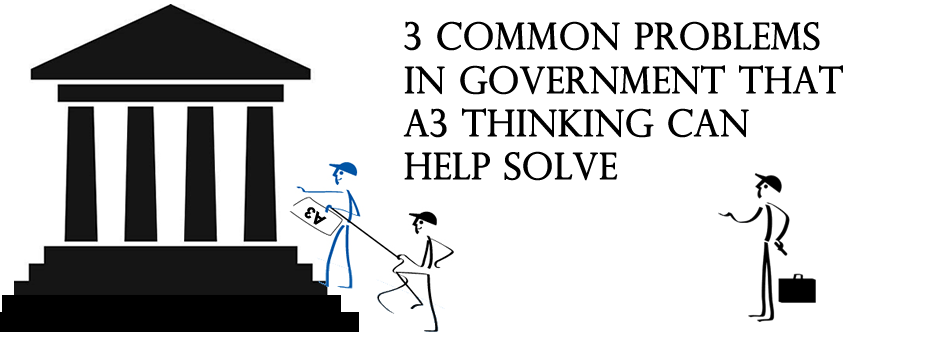I’m always surprised at how little the public sector uses A3 thinking to tackle their toughest challenges. It’s the same thing every time – the government often tries to solve symptoms, rather than analyzing root causes and establishing fixes for them. Government agencies are understaffed and overworked, meaning that they’re most concerned about the fires right in front of them – not the spark that caused it. It’s an unfortunate reality, because there are a number of common problems the public sector faces that A3 thinking could help them with. Here are a few that I often see:
- Translation of strategic goals into measurable objectives. This problem often comes about when there is a new leader in a public agency. Oftentimes they come in, present their 100-day plan to change the world, and assign the employees to make that plan reality. The problem is that these leaders are a transitory, turnstile type of leadership, where they’re around for maybe 36 months and then move on. In the face of all this change, the agency’s long-term employees still have regular jobs to do. So the problem becomes, “How do I continue fulfilling the tasks I’m committed to doing every day, while at the same time supporting strategic goals?”An A3 can be used for planning purposes – it can be laser-focused on a goal and decompose it into its composite objectives, each of which should be measurable, and then those objectives should be traceable, someway, somehow, to the long-term employees’ work in progress. I say “should be traceable” because if the A3 shows that employees’ work doesn’t directly correlate with the business objectives, then that’s a whole other conversation. You may find that some tasks or even entire positions that you thought were critical are not adding value.I once helped the cybersecurity department of a major energy-related agency with a problem like this. I was conducting their strategic planning for 2016 under the head of a new CIO. The CIO had a new strategic direction for his department, but the challenge was aligning that direction with the tasks that the long-term employees carried out every day. The A3 we worked on together helped us plan that out, again, by breaking down the bigger goal into measurable objectives that aligned with what the employees were already doing daily.
- Security testing takes too long. This often relates specifically to IT departments. In government IT, any major system enhancement or new system installation needs an Authorization To Operate (ATO) – a process that can take anywhere from three to nine months to be issued, AFTER you’ve gone through all the setup work. Naturally, all fingers point to the ATO issuer, making accusations like, “What’s taking so long?” and “You must be understaffed!” They may hire contractors to do that same work. And that right there is fighting a symptom. They fight the delays without performing a root-cause analysis via A3. And that’s a missed opportunity because I’ve seen A3s reveal what’s REALLY at the heart of the problem – the value stream.I remember helping a government agency that was struggling with long security-testing cycles. They had kept hiring contractors to try speed up the process, which of course never showed improvement. But after taking the leaders through the A3 process we found the root cause – the IT department never submitted their ATO request until their entire system was set up – a process that altogether took nearly six months. We found that it would be much more efficient to seek ATOs for individual parts of the system as they were set up, rather than waiting until the end. The results were tremendous – we reduced the ATO lead-time from six months to just three weeks.
- Ineffective business development. Prospective federal contractors often experience this problem. We all know business development isn’t easy – I’d argue that it’s even harder in government, where you have enormous sales cycles thanks to committee decisions, ever-changing federal acquisition regulations, and hypercompetition. If you are not able to quantifiably prove beyond a shadow of a doubt that you are better, faster, cheaper than others, then you’re just another face in the crowd – and that leads to ineffective business development. The key is to distinguish yourself.In situations like this, A3s are a great way to gather your data and figuring out how you know your business development is ineffective. I’ve seen this in every company I’ve ever worked for. You can first break down your problem into what exactly is ineffective. Is it just because you haven’t made it to the final rounds of the selection process? Is it because you’re not getting initial meetings? Are you not influencing your potentials in your statements of worth? The million-dollar question is, at what stage of the sales cycle are you saying, “This isn’t effective.” Then, once you’ve narrowed down the problem focus, you can segue into the root-cause analysis to find out why this is a problem. And from there you can create your possible countermeasures and assess how you’re going to determine whether they’ve succeeded or failed. And from there you’ll test your theories and apply PDCA to the results. Then rinse and repeat.
Managing to Learn with the A3 Process
Learn how to solve problems and develop problem solvers.





